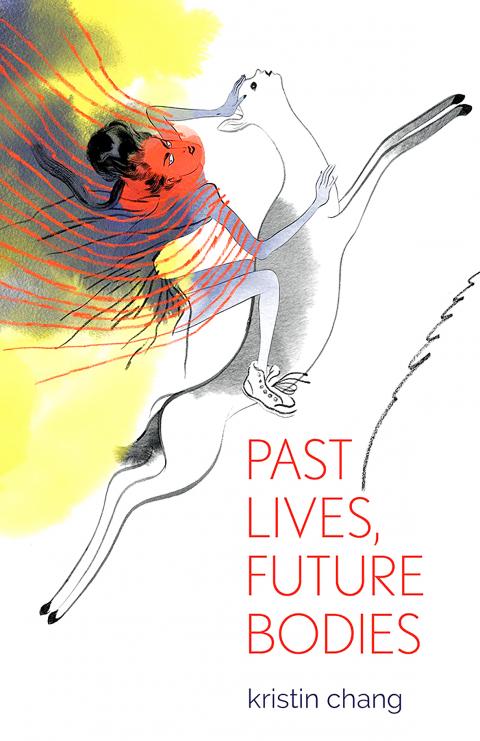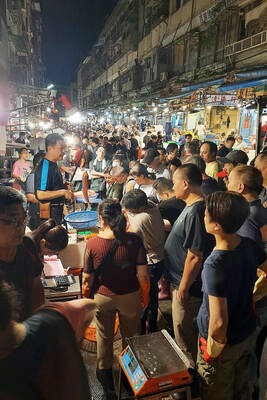As long as Kristin Chang (張欣明) can remember, her mother has attributed her likes, dislikes, dreams and phobias to past lives. A Buddhist, her mother raised Chang with constant reminders of reincarnation: Chang’s love of cats was a sign that she had once been one; her love of New York City meant that, in a past life, she must have been a New Yorker.
WEIGHED DOWN PAST
Burdened by these legacies, Chang longed for a childhood with Western sensibilities — the individualistic, self-reliant culture she witnessed everywhere in her hometown of Montebello, California. Instead, her Taiwanese immigrant family brought traces of their past to the US.

Photo courtesy of Kristin Chang
“I used to think that the very idea of reincarnation stripped me of my agency,” Chang, 19, says. “As if I weren’t a real person, just a collection of past lives; like cats and New Yorkers.”
She fought the label, adopting Christianity and dismissing her mother’s faith.
As an adult, though, Chang feels grounded in her mother’s reincarnation myths, making it a central theme of her debut chapbook, Past Lives, Future Bodies , which will be published in October by Black Lawrence Press. The book seeks to reconcile her origins, both in this life and past ones, and embraces the yet-unknown. In the process, Chang reckons with her family’s experiences.
Chang’s writing did not always serve as such an overt tribute to her roots: as a younger writer, she felt the urge to distance herself from her heritage, in writing as well as everyday life. Feeling removed from her Taiwanese roots, she often aspired to writing like the white American mainstream she read at school.
“The more I wrote like this white edgy hipster, I realized this was another version of colonizing language,” Chang says. “And I felt like an impostor. I realized that I wanted to be a part of another canon of voices, one that I can identify with.”
ASIAN-AMERICAN DIASPORA
For her, poetry has also helped navigate what it means to be part of the Asian-American diaspora, a larger community which transcends her identity as a Taiwanese-American.
“Being Asian-American is an important political choice for me,” she says. Despite the inorganic nature of the label, which has few cultural commonalities, it has become a way for her to connect with other writers who explore the same diaspora.
In centering the Asian-American community, she joins a host of contemporary poets dealing with strikingly similar identity struggles. Acclaimed poets like Ocean Vuong, Cathy Park Hong and Chen Chen have begun to form the canon Chang envisioned when she first began to break away from the white American literary establishment.
For a writer who places Taiwan at the heart of her authorial identity, Chang is surprisingly distant from her relatives’ home country: she has only been to Taiwan once, years ago. As a result, Chang sometimes feels like an stranger in her own heritage, too removed from Taiwanese culture to participate in it.
“There’s a degree of separation that can seem daunting at times,” she says.
Her primary knowledge of Taiwan comes from an amalgamation of family stories and recollections of her only visit. She preserves this patchwork Taiwan carefully in her poems, using her writing to imagine herself in it.
“In Taiwan the rain spits on my skin. / I lose the way to my grandmother’s / house, eat a papaya by the side of the road,” she writes in her Pushcart Prize-winning poem Yilan.
Chang’s persona seems intimately comfortable with Taiwan, despite her alienation from it.
As with any myth, though, her construction of Taiwan is off-color, not quite reaching the truth. In Yilan, Chang describes herself as watching a typhoon from the 65th floor of a Marriott; “smaller buildings lean / like thirst to water” in her invented narrative. But in the real Taipei, there are no 60-floor hotels.
Chang knows that her experience of Taiwan is distanced through a filter of Asian-American identity and diaspora.
“I try not to write from a purely autobiographical place,” she says, pointing to her descriptions of her parents and grandparents peppered throughout her narrative.
As Chang embraced her mother’s reincarnation myths, her poetry similarly serves as a reclamation of identity. Using secondhand stories of a country she has never known herself, she carves out a new Asian-American mythology of her past lives and future bodies.

The Taipei Times last week reported that the rising share of seniors in the population is reshaping the nation’s housing markets. According to data from the Ministry of the Interior, about 850,000 residences were occupied by elderly people in the first quarter, including 655,000 that housed only one resident. H&B Realty chief researcher Jessica Hsu (徐佳馨), quoted in the article, said that there is rising demand for elderly-friendly housing, including units with elevators, barrier-free layouts and proximity to healthcare services. Hsu and others cited in the article highlighted the changing family residential dynamics, as children no longer live with parents,

It is jarring how differently Taiwan’s politics is portrayed in the international press compared to the local Chinese-language press. Viewed from abroad, Taiwan is seen as a geopolitical hotspot, or “The Most Dangerous Place on Earth,” as the Economist once blazoned across their cover. Meanwhile, tasked with facing down those existential threats, Taiwan’s leaders are dying their hair pink. These include former president Tsai Ing-wen (蔡英文), Vice President Hsiao Bi-khim (蕭美琴) and Kaohsiung Mayor Chen Chi-mai (陳其邁), among others. They are demonstrating what big fans they are of South Korean K-pop sensations Blackpink ahead of their concerts this weekend in Kaohsiung.

Taiwan is one of the world’s greatest per-capita consumers of seafood. Whereas the average human is thought to eat around 20kg of seafood per year, each Taiwanese gets through 27kg to 35kg of ocean delicacies annually, depending on which source you find most credible. Given the ubiquity of dishes like oyster omelet (蚵仔煎) and milkfish soup (虱目魚湯), the higher estimate may well be correct. By global standards, let alone local consumption patterns, I’m not much of a seafood fan. It’s not just a matter of taste, although that’s part of it. What I’ve read about the environmental impact of the

Oct 20 to Oct 26 After a day of fighting, the Japanese Army’s Second Division was resting when a curious delegation of two Scotsmen and 19 Taiwanese approached their camp. It was Oct. 20, 1895, and the troops had reached Taiye Village (太爺庄) in today’s Hunei District (湖內), Kaohsiung, just 10km away from their final target of Tainan. Led by Presbyterian missionaries Thomas Barclay and Duncan Ferguson, the group informed the Japanese that resistance leader Liu Yung-fu (劉永福) had fled to China the previous night, leaving his Black Flag Army fighters behind and the city in chaos. On behalf of the